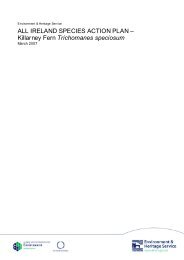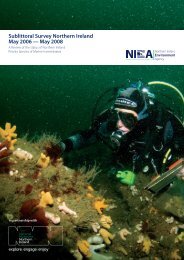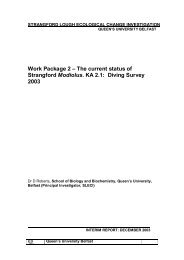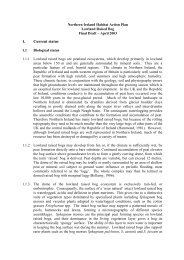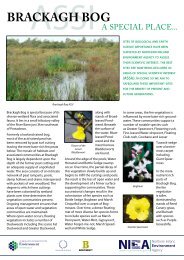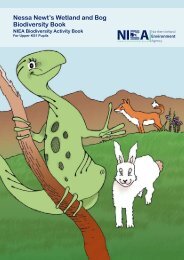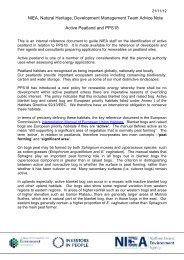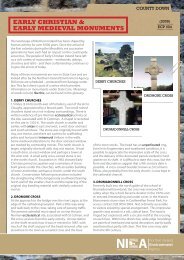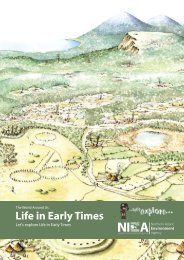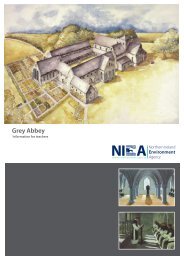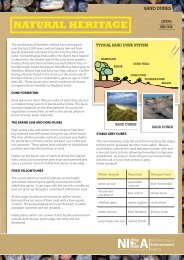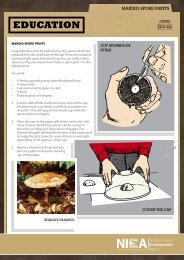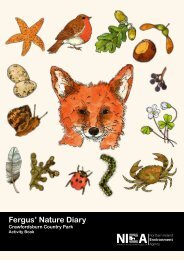Binevenagh Nature Reserve Information for Teachers (.PDF 0.97
Binevenagh Nature Reserve Information for Teachers (.PDF 0.97
Binevenagh Nature Reserve Information for Teachers (.PDF 0.97
You also want an ePaper? Increase the reach of your titles
YUMPU automatically turns print PDFs into web optimized ePapers that Google loves.
www.ni-environment.gov.uk<br />
Plants<br />
The crags of the cliffs are the habitat of rare sub-arctic and<br />
alpine plants such as the mountain avens and the purple<br />
saxifrage. These flowers grow in very few places in Ireland,<br />
but they have survived high on the cliffs <strong>for</strong> thousands of<br />
years since the last Ice Age where the soils and micro-climate<br />
suit them. The cliffs face north and are there<strong>for</strong>e colder than<br />
the surrounding area. The cliffs are also the habitat of rare<br />
mosses and clinging on to the cliffs are some of Ireland’s<br />
rarest tree, the juniper. On the scree slopes below the cliffs<br />
are rare ferns.<br />
An important aspect of the reserve is the grassland below the<br />
cliffs. In their natural state there would not be grasslands here<br />
at all. The natural vegetation of most of Ireland is woodland.<br />
Be<strong>for</strong>e the first farmers arrived here 6,000 years ago 80% of<br />
Ireland was covered in thick deciduous <strong>for</strong>est. These Neolithic<br />
farmers began to cut down these original woods to provide<br />
fuel and building material <strong>for</strong> their homes and farms and<br />
to make way <strong>for</strong> their fields. Over the next 6,000 years the<br />
<strong>for</strong>ests gradually disappeared to perhaps 1% of the total<br />
area of Ireland. The fields were largely used <strong>for</strong> animal<br />
grazing. It is the cattle and sheep that prevent the <strong>for</strong>est<br />
re-establishing itself because they eat the young shoots<br />
of any trees that might begin to grow.<br />
We often think of the countryside as completely natural and<br />
the town landscape as being man made. This is not really<br />
the case. All of our landscapes, whether they are in the<br />
countryside or in the middle of towns, have been to a greater<br />
or lesser extent affected by people. There is no completely<br />
natural landscape in Ireland. Since people arrived here 9,000<br />
years ago they have altered the landscape in many ways and<br />
the area of the reserve is just one example. Wild animals like<br />
bears and wolves, which lived in the <strong>for</strong>ests, have become<br />
extinct. Domestic animals have been allowed to graze and<br />
crops have been planted. A huge coniferous <strong>for</strong>est has been<br />
planted nearby. There are buildings, stone walls and fences.<br />
The landscape we see today is a combination of natural<br />
<strong>for</strong>ces and the work of people. <strong>Binevenagh</strong> reserve is a good<br />
example of this process.<br />
Although the grassland below the cliff is not strictly natural<br />
it is very important that it is kept in its present state. The<br />
grassland below the cliffs has never been treated with<br />
fertiliser or pesticides. This makes it fairly rare. As long as it is<br />
sensibly grazed it will remain the home of a wide variety<br />
of grasses and flowers. These may have been common at one<br />
time in many locations but modern farming practice has led<br />
to their becoming much rarer.<br />
Bracken Fern<br />
Purple Saxifrage<br />
Mountain Avens<br />
<strong>Binevenagh</strong> <strong>Nature</strong> <strong>Reserve</strong><br />
4



